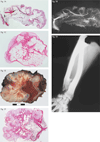Multiple osteochondromas: clinicopathological and genetic spectrum and suggestions for clinical management
- PMID: 20233460
- PMCID: PMC2840003
- DOI: 10.1186/1897-4287-2-4-161
Multiple osteochondromas: clinicopathological and genetic spectrum and suggestions for clinical management
Abstract
Multiple Osteochondromas is an autosomal dominant disorder characterised by the presence of multiple osteochondromas and a variety of orthopaedic deformities. Two genes causative of Multiple Osteochondromas, Exostosin-1 (EXT1) and Exostosin-2 (EXT2), have been identified, which act as tumour suppressor genes. Osteochondroma can progress towards its malignant counterpart, secondary peripheral chondrosarcoma and therefore adequate follow-up of Multiple Osteochondroma patients is important in order to detect malignant transformation early.This review summarizes the considerable recent basic scientific and clinical understanding resulting in a multi-step genetic model for peripheral cartilaginous tumorigenesis. This enabled us to suggest guidelines for clinical management of Multiple Osteochondroma patients. When a patient is suspected to have Multiple Osteochondroma, the radiologic documentation, histology and patient history have to be carefully reviewed, preferably by experts and if indicated for Multiple Osteochondromas, peripheral blood of the patient can be screened for germline mutations in either EXT1 or EXT2. After the Multiple Osteochondroma diagnosis is established and all tumours are identified, a regular follow-up including plain radiographs and base-line bone scan are recommended.
Figures







Similar articles
-
Secondary peripheral chondrosarcoma evolving from osteochondroma as a result of outgrowth of cells with functional EXT.Oncogene. 2012 Mar 1;31(9):1095-104. doi: 10.1038/onc.2011.311. Epub 2011 Aug 1. Oncogene. 2012. PMID: 21804604
-
Multiple osteochondromas.Orphanet J Rare Dis. 2008 Feb 13;3:3. doi: 10.1186/1750-1172-3-3. Orphanet J Rare Dis. 2008. PMID: 18271966 Free PMC article. Review.
-
Somatic loss of an EXT2 gene mutation during malignant progression in a patient with hereditary multiple osteochondromas.Cancer Genet. 2015 Mar;208(3):62-7. doi: 10.1016/j.cancergen.2015.01.002. Epub 2015 Jan 16. Cancer Genet. 2015. PMID: 25744876
-
EXT-mutation analysis and loss of heterozygosity in sporadic and hereditary osteochondromas and secondary chondrosarcomas.Am J Hum Genet. 1999 Sep;65(3):689-98. doi: 10.1086/302532. Am J Hum Genet. 1999. PMID: 10441575 Free PMC article.
-
Osteochondromas: review of the clinical, radiological and pathological features.In Vivo. 2008 Sep-Oct;22(5):633-46. In Vivo. 2008. PMID: 18853760 Review.
Cited by
-
Osteochondroma of bilateral mandibular condyle: a case report.Int J Clin Exp Med. 2015 Feb 15;8(2):2989-92. eCollection 2015. Int J Clin Exp Med. 2015. PMID: 25932269 Free PMC article.
-
Bilateral Scapulothoracic Osteochondromas in a Patient With Hereditary Multiple Exostosis: A Case Report and Review of the Literature.Orthop Rev (Pavia). 2016 Sep 19;8(3):6501. doi: 10.4081/or.2016.6501. eCollection 2016 Sep 19. Orthop Rev (Pavia). 2016. PMID: 27761218 Free PMC article.
-
Malignant progression in two children with multiple osteochondromas.Sarcoma. 2010;2010:417105. doi: 10.1155/2010/417105. Epub 2010 May 9. Sarcoma. 2010. PMID: 20467466 Free PMC article.
-
The Rizzoli Multiple Osteochondromas Classification revised: describing the phenotype to improve clinical practice.Am J Med Genet A. 2021 Nov;185(11):3466-3475. doi: 10.1002/ajmg.a.62470. Epub 2021 Sep 3. Am J Med Genet A. 2021. PMID: 34477285 Free PMC article.
-
Multiple Distal Femoral Osteochondromas Encasing Popliteal Neurovascular Bundle.Cureus. 2023 Oct 3;15(10):e46396. doi: 10.7759/cureus.46396. eCollection 2023 Oct. Cureus. 2023. PMID: 37927696 Free PMC article.
References
-
- Mulder JD, Schütte HE, Kroon HM, Taconis WK. Radiologic Atlas of Bone Tumors. 2. Elsevier, Amsterdam; 1993.
-
- Bovee JVMG, Hogendoorn PCW. In: World Health Organization Classification of Tumours. Pathology and Genetics of Tumours of Soft Tissue and Bone. Fletcher CDM, Unni KK, Mertens F, editor. IARC Press, Lyon; 2002. Multiple osteochondromas.
-
- Dahlin's Bone Tumors General Aspects and Data on 11,087 Cases. 5. Lippincott-Raven Publishers, Philadelphia; 1996.
-
- Legeai-Mallet L, Munnich A, Maroteaux P, Le Merrer M. Incomplete penetrance and expressivity skewing in hereditary multiple exostoses. Clin Genet. 1997;52:12–16. - PubMed
-
- Schmale GA, Conrad EU, Raskind WH. The natural history of hereditary multiple exostoses. J Bone Joint Surg [Am] 1994;76A:986–992. - PubMed
LinkOut - more resources
Full Text Sources
Miscellaneous
